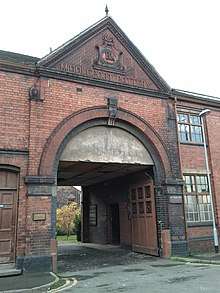Middleport Pottery
Middleport Pottery was built in 1888 by Burgess & Leigh Ltd (founders William Leigh and Frederick Rathbone Burgess). It is located at Middleport, Stoke-on-Trent, England.[1] The buildings, which still house an active pottery, are protected for their historic interest. Middleport Pottery is owned and operated by Re-Form Heritage.

History
Middleport Pottery has been described as a “model pottery" of the Staffordshire pottery industry at the time of its construction. Its scale and linear organisation contrast with the constricted sites and haphazard layout of traditional potteries such as the Gladstone Pottery Museum.[2]
It was designed to make all production processes more efficient and to improve conditions for the workforce. The passageways between the ranges were just wide enough for a cart to get through, and for the easy movement of workers and pottery. Finished pottery was placed (using the crane next to the packing house) straight onto barges on the Trent and Mersey Canal waiting to take the ceramics out to the coast for international export. Alternatively they were sent out by horse and cart via the road.
The Boulton steam engine powered the machinery for mixing clay and continued to be in use until the coal strike of the 1970s. It was fed by a large boiler that also provided steam for heating and drying pottery.
Middleport Pottery had many pre-eminent designers over the years. Charlotte Rhead worked there from 1926-1931 producing her exquisite tube-lined designs, and David Copeland worked at the pottery in the 60s, bringing new modern designs while still using traditional copperplate engraving skills.
Conservation status of Middleport Pottery
The pottery was given listed building status in the 1970s.[3] By this time six of the seven bottle ovens on the site had been demolished. The surviving bottle oven was given its own listing.[4] In 1988 the course of the Trent and Mersey Canal through Stoke-on-Trent was designated a linear conservation area.
Urban decay
English Heritage put the canal conservation area on the "Conservation Areas at Risk" register in 2010, in large part because of urban decay caused by the decline of traditional industries. A 2011 review of the conservation area noted that Middleport Pottery was a building at risk.[5]
The Prince’s Regeneration Trust / Re-Form Heritage involvement
In 2010 the pottery was acquired by Denby Holdings Limited, the parent company of the well-known UK ceramics and consumer goods manufacturer Denby Pottery.
In 2011 Middleport Pottery was at serious risk of closure because of the very poor state of repair of the buildings. This would have seen the loss of jobs and substantial buildings of historic significance would have been left to further degenerate. In the same year Re-Form Heritage stepped in to buy and save the buildings and began a £9 million project to revitalise them.
After Re-Form Heritage bought the site Denby Pottery continued to operate in the factory as a tenant. The production of Burleigh Pottery has continued uninterrupted at the site since it opened in 1889.
The restoration work was led by Feilden Clegg Bradley Studios and included a varied and extensive programme of training and educational activities to support the local community in skills provision with an emphasis on traditional British craftsmanship. The pottery opened to the public as a visitor destination in July 2014 following the three-year regeneration.
The restoration enabled Burleigh Pottery to remain on-site, saving local jobs and craftsmanship. In total the restoration has saved 50 local jobs and created 70 more. The unused buildings have been developed to provide attractive accommodation for workshops, enterprise space, craft and community areas, a cafe, a gallery and a heritage visitor centre.[6]
Today
Following renovations, Middleport Pottery was opened to visitors in 2014. The pottery has enjoyed rising visitor numbers, and a number of businesses are based at the site. Burleigh Pottery is still produced at the site using traditional craftsmanship. The Old Packing House was refurbished and became the new Prince of Wales Studios that is open as a business home for craftspeople to work and exhibit their products. The Princes Regeneration Trust granted £200,000 to the Pottery towards the conversion and Prince Charles (the Prince of Wales) helped open the Studios in January, 2016, including unveiling some signs; .[7]
Since it opened as a visitor destination, the pottery has won eight awards: a RIBA National Award for architectural excellence; three RIBA West Midlands Awards; a Europa Nostra Award for heritage; a Civic Trust AABC Conservation Award for building conservation; a Placemaking Award for heritage; and a Heritage Open Days’ Community Champions Award.
It was the filming location for three seasons of The Great Pottery Throw Down, and was recently featured in an episode of Peaky Blinders.[8]
References
- Middleport Pottery
- Stoke on Trent Historic Buildings Survey; Baker D: Potworks: London: 1991-: P.89-93).
- "Middleport Pottery (Burgess, Dorling & Leigh)". Retrieved 30 November 2014.
- "Bottle Kiln at the Middleport Pottery". Listed buildings in SOT. Retrieved 30 November 2014.
- "The Trent & Mersey Canal Conservation Area Review" (PDF). Retrieved 1 December 2014.
- "Middleport Pottery, Stoke-on-Trent". Historic England. Retrieved 2 January 2019.
- Studios opened by Prince Charles https://staffslive.co.uk/2016/01/prince-charles-opens-new-pottery-studios-burslem/
- https://www.stokesentinel.co.uk/news/stoke-on-trent-news/bonus-scene-peaky-blinders-filmed-3353677
External links
- website
- Historic England. "Middleport Pottery (Burgess and Leigh) (Grade II*) (1297939)". National Heritage List for England. Retrieved 17 February 2016.